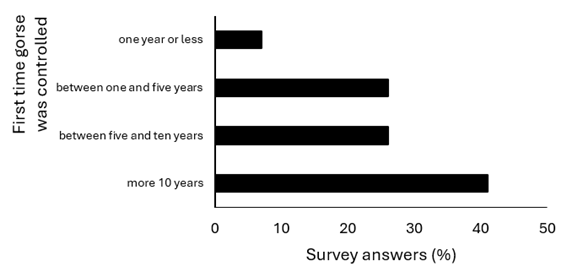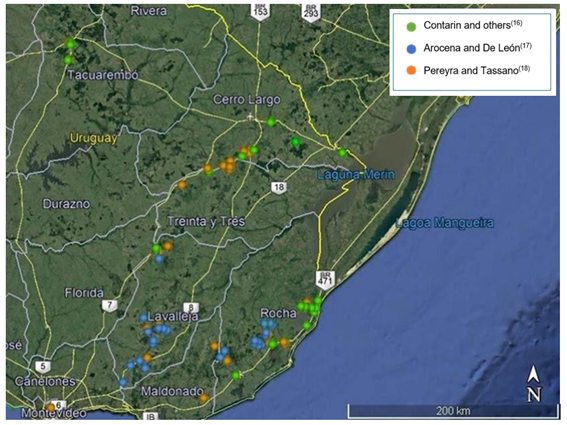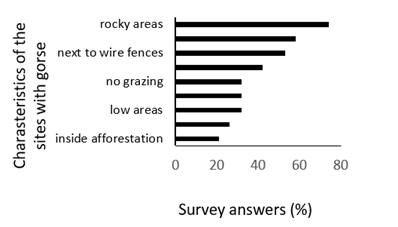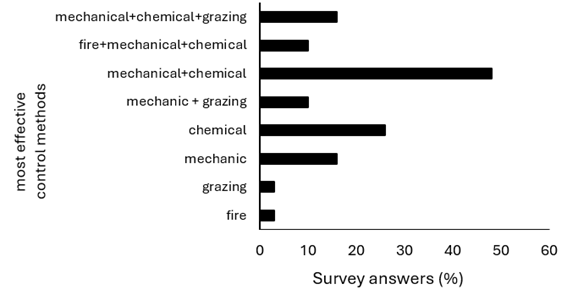1. Introduction
The problem of Invasive Alien Species (IAS) is considered as the second cause of loss of biological diversity in the world. According to the International Union for Conservation of Nature (IUCN), Ulex europaeus L. (gorse) is among the 100 most harmful invasive alien species worldwide1. It can affect native species by competence or even displacing them, which affects the composition, structure and processes of ecosystems and causes significant economic losses and environmental degradation, as well as damage to human and animal health 2)(3) 4.
Ulex europaeus is a legume native to central-western Europe and North Africa5. It is shrubby, woody, thorny, and perennial. Its morphological and physiological characteristics make it a very competitive species, with a great capacity to advance and colonize free spaces. It can grow in various types of soil, in disturbed areas and in soils poor in nutrients, since it is capable of fixing up to 200 kg/h/year of nitrogen, and, due to this, it does not present great soil requirements 6)(7) . It is quite clear, therefore, that landscape characteristics play an important role on the establishment and spread of gorse, but few studies have examined how transportation structures affect these processes8.
The adult plant blooms after 18 months; it can have flowers all year round, with peaks in spring and autumn, although in some places it blooms once a year only in spring. Its main form of natural dispersion is by seed, it occurs in times of warm temperatures, when the pods open and expel them9. It produces large seed banks in the soil, reaching about 20,000 seeds/m2/year, and they can remain viable in the soil for up to 30 years10. It presents a rapid vegetative regeneration after disturbances by cutting or fire. In addition, its cover is dense, which limits the availability of light to understory species 6)(11) 12.
The climates suitable for its presence are those with relatively low seasonal fluctuations in temperature, corresponding to temperate oceanic climates13; it can survive periods of low rainfall, although its climatic niche excludes areas with annual rainfall of less than 300 mm per year 6)(7)8)(9)10)(11)12)(13) . It is widely distributed around the world and has been introduced intentionally as hedgerows to contain grazing animals, as fodder, and accidentally with imported animals and hay. In South America it has been reported as invasive in Argentina, Chile, Brazil, Colombia, Bolivia and Ecuador14.
In Uruguay it was introduced for ornamental use and to form living fences, and there are records of its presence in the country since 189015; however, evidence of its invasion has been reported more recently in the southeast 16)(17)18)(19) . The Uruguayan territory has been the one with the highest rates worldwide in recent years20. Between 1990 and 2011 there was a change in land use, associated with productive sectors, agriculture, livestock and the forestry sector. In the case of the livestock sector, the main responsible for the change was the shepherd, who decreased his stock by 65%21, a factor that could have favored the advance of gorse expansion22. For the forestry sector, the period presented an accumulated increase of 2.4 million hectares21. The invasion constitutes a problem in the forestry sector, it makes forest management and harvesting operations difficult23. In the livestock sector, it affects natural grasslands, seriously reducing their surface, acting as a barrier to the transit of cattle and reducing the productivity of the natural field, among other effects 16)(21) . Contarín and others16 and Arocena and De León17 reported the presence of the invader in 22 and 38 sites in the eastern part of the country, respectively. The species is part of the list of priority invasive alien species for control in the country defined by the Committee on Invasive Alien Species19.
The objectives of the case of study are i) to contribute to updating the record of the presence of Ulex europaeus in the eastern region of Uruguay, with emphasis on beef cattle farms; ii) to collect information on the environmental conditions where it invades, and the control measures for Ulex europaeus applied by livestock and forestry producers in the eastern region.
2. Materials and methods
To identify the sites with the presence of gorse and the environmental characteristics, surveys were conducted with 31 producers in the eastern part of the country. The choice of producers was made through consultation with local and institutional referents. The survey consisted of closed questions that included the following aspects: data and characterization of the respondent, gorse presence on the property, and environmental characteristics associated with it, such as landscape, soil characteristics, proximity to watercourses, predominant vegetation, location in the landscape, and control measures applied. Between May and August 2020, surveys were carried out on livestock and forestry producers by phone calls, WhatsApp messages and emails. Subsequently, an interview with open-ended questions was conducted with nine producers, selected based on whether they carried out active control on the farm. Likewise, a survey was applied using the "snowball" technique 24)(25) aimed at producers and advisors to complete the registry of invaded sites in other regions of the country. This methodology consists of sending the survey to known contacts and then them forwarding it to their contacts, in order to spread the survey. The questionnaire was carried out using a Google form and reached 35 agronomist and forest farmers. The responses were processed as frequencies with descriptive statistics.
A gorse presence map was generated using Google Earth, from the sites provided by the respondents. The new records were added to those reported by Contarín and others16 and Arocena and De León17. To avoid duplicates, the criterion applied was to consider that those records that were less than 3 km apart correspond to the same site.
3. Results
3.1 Characterization of the participants
Of the 38 respondents, 68% were linked to livestock production, 13% to forestry production, and 19% to mixed production. In relation to the extension of the properties surveyed, 52% have an extension of less than 500 ha, 26% between 501 and 1,250 ha, and 22% more than 1,250 ha. The presence of gorse was reported in all the properties.
3.2 Update of gorse records
Based on surveys of farmers and agronomists in the eastern region of the country, and on the snowball survey, 43 sites with gorse presence were reported, five of these sites coincide with the thesis by Arocena and De León17 (three in Rocha and two in Lavalleja), so 38 new sites are reported, in addition to previous surveys by Contarín and others16, and Arocena and De Leon17 (Figure 1).
3.2 Characteristics of the sites with presence of gorse
The characteristic landscape of the area with presence of gorse was mainly hills, with medium-depth soils that are moderately shallow and rocky on the surface, with grasslands and riparian vegetation.
In relation to the identified sites’ characteristics that present gorse invasion, in the surveys half of the producers identify: rocky areas, high areas, accompanied by wire fences and the sides of roads. Some respondents commented that water springs and small creeks play an important role in the transport of seeds, since there is gorse near them (Figure 2).
3.3 Gorse control methods
With the exception of one case, respondents are aware of some method to control invasive species. One hundred percent of respondents have access to machinery and some equipment to control gorse, and 90% of those surveyed carry out controls’ measurements. The 10% that do not do it is because they consider it expensive, and/or because they have had unsuccessful results.
Of those who applied gorse control measures, 41% indicated that they have carried them out periodically for more than 10 years (Figure 3). Regarding the efficacy of the control, 97% indicated that they detected the presence of gorse 30 days after the measures of control were applied.

Figure 3: Percentage of respondents on the first time they applied measures of gorse control (n = 31)
The percentage of respondents regarding the application time of mechanical and chemical controls was 60 and 64% in spring, and 44 and 43% in autumn, respectively. From the surveys it appears that the methods reported as most effective are those that combine control techniques, such as mechanical and chemical methods (Figure 4).
The analysis of the interviews showed that in relation to (local) social organization, the interviewees consider the joint work of neighbors in the area to be very important, but it is not practiced. The reasons they pointed out are the difficulty in coordination since each case presents different realities and resources. In relation to this, they mentioned: the time available, the degree of invasion, and the knowledge they have in order to carry out the control, the costs, the workforce, and the farm machinery available. Likewise, an additional difficulty for the joint coordination of control measures is that there are beef cattle farmers who do not identify the presence of gorse as a problem.
4. Discussion
In this study, it was possible to incorporate new records of the presence of gorse in beef cattle farms in the departments of Cerro Largo, Tacuarembó, Treinta y Tres and Florida, as well as in Maldonado and Montevideo. This shows that the distribution of gorse would not be exclusively associated with the eastern region of the country.
The respondents associate the presence of gorse with characteristics of a wide range of physiographic conditions of sites, such as superficial and deep soils, which shows great phenotypic plasticity.
In relation to the control method chosen by producers and technicians, it is associated with the resources available. Most of them carried out a post-control follow-up, and detected the presence of gorse in the controlled area, which would indicate difficulties in reducing abundance or preventing its expansion with a single control intervention. According to the experiences collected and the background 4)(26) 27, the combinations of several methods generate greater control efficacy.
4.1 Update of gorse records
From the surveys carried out, particularly in the eastern part of the country, the departments where an increase in sites with gorse infestation was identified were Rocha and Lavalleja. This confirms the importance of the presence of the species in these departments, and the challenge of analyzing and understanding what would be the causes that promoted its successful dispersion is posed.
According to Figure 1, in relation to the location of sites with gorse, it can be inferred that the closeness to communication roads would favor dispersion, as reported. In this sense, according to León Cordero and others8, the structure of the road networks can facilitate the spread of gorse to the different departments, probably associated with the traffic of heavy vehicles that transport wood logs, cattle, among other loads, coming from infested regions. At the same time, other means of dispersion must also be taken into account, such as the handling of tools, agricultural machinery, vehicles and operators, as well as the movements of animals in the properties.
4.2 Characteristics of the sites with the presence of gorse
The respondents associate the presence of gorse with characteristics of the site such as superficial soils, rocky and stony areas, high areas, what agrees with Hoshovsky10, who pointed out that gorse can develop on various types of soil, but it is generally associated with sandy or rocky soils. In addition, these types of soil have low water retention, and, according to studies carried out by Guido and others26, the water deficit would increase the incidence of the species. Likewise, some respondents also reported its presence in deeper soils, for example. This would show its tolerance to a wide range of soil humidity conditions, which demonstrates its great phenotypic plasticity 6)(27) .
The results obtained from the interviews agree with those of the survey, indicating that high and rocky areas, soils without vegetation cover, as well as soil removal favor the emergence and establishment of plants from the soil seed bank. In particular, in forest farms, after harvest the soil is exposed to greater availability of light, and this may be one of the moments with the greatest risk of invasion of the system due to promotion of germination and emergence from the seed bank. Another characteristic mentioned associated with the invasion of the species is the absence of sheep. Forest producers mention that, in their history of agricultural use, the sites were beef cattle ranches, mostly with the presence of sheep, and had no changes in land use. Interviewees suggest that when grazing is done with a low stocking rate, it would not be enough to control invasive species. Likewise, intensive grazing would not be recommended either, due to the reduction in the cover and height of the natural mat, which would generate less competition with gorse, favoring its growth and development, as proposed by Rees and Hill28 and Clements and others6. The producers also indicated that sheep grazing would be more effective to control the invader than cattle grazing, so the absence of the former could be a factor that favors the invader's success. As previously stated, the reduction in stock by 65% between 1990 and 201121 could be a determining factor in the colonizing and expansive success of the invader in the region. Leon Cordero and others8 observed that in the grasslands of Rio Grande do Sul the livestock selectively feed on various life stages of gorse: cows can only feed on gorse seedlings, while sheep and horses prefer adult gorse. The change in land use, evidenced mainly by forestry activity, could have promoted the invasion of gorse, in agreement with what was previously commented on the change in land use that occurred in Uruguay from 1990 according to the MGAP-DIEA21. The generation of bare soils, as well as disturbed soils, as in forest management, favors the development of gorse due to the absence of competition with other plants. What was reported in the responses obtained coincides with Broadfield and McHenry29, who propose the degradation and loss of stability of the soil as a facilitator of invasion.
In relation to the aspect of invasion and the proximity to the watercourse, it is considered by producers as a seed transport factor, as reported by Clements and others6. To understand the mechanisms that operate in the dispersal process of the species in this region, it is necessary studies that look into the detection of the environmental factors that promote it.
4.3 Gorse control methods
The responses indicate the use of various methods, alone or in combination, as well as their frequency of application. According to Castro30, this diversity of methods applied would confirm, on the one hand, that there are no single effective control measures to adequate to all situations. The choice of control methods depends on factors such as the size of the plant, the density of the invasion, the type of production concerned, the availability of time, and the costs of control.
The combination of chemical and mechanical controls was identified as the most effective, as reported by Balero and Gándara31, Davies and others32, and Roberts and Florentine4. However, when defining the use strategy when applying them, the majority opted for the individual application of chemical control or grazing management. This is explained because the costs turn out to be a limiting factor, as mentioned by some producers. On the other hand, this economic cost also affects the frequency of application necessary to achieve greater control success. Likewise, most of the producers carried out post-control monitoring, and detected the presence of gorse in the controlled area, which would indicate the difficulties to reduce abundance or prevent its expansion if it were done with a single intervention.
In summary, this study intended to contribute to the local perspective of producers and technicians on the invasion of Ulex europaeus (gorse) in the eastern region of the country, as well as to aspects related to the invasiveness of the environment and the control measures commonly used to avoid or minimize the invasion. We understand that the gorse invasion problem is complex and requires prevention strategies and permanent monitoring, combined and periodic early control. The approach to solutions implies a level of individual and collective commitment, which is essential to achieve long-term changes.
5. Conclusions
We found that there has been an update in the report of the presence of Ulex europaeus in places and departments where previously there were no records of it. The update of the records of the invasive species in the country provides a total of 38 sites distributed in eight departments (Cerro Largo, Florida, Lavalleja, Maldonado, Montevideo, Rocha, Tacuarembó, and Treinta y Tres).
Beyond the intrinsic capacity of colonization, establishment and dispersion that Ulex europaeus presents as an invader, human intervention would have favored its development, beginning with the change in land use since the 1990s, favoring its increase in areas already invaded and the colonization of new areas. The presence of the invader was reported in disturbed and degraded environments, in superficial soils, high parts of land, and in the vicinity of watercourses.
Although there is a positive assessment of the results in the use of combined controls, as the most effective, the most applied management and control methods were grazing, chemical, and secondly the mechanical.
6. Considerations
Given the demand of the productive sector, some topics and lines of research are proposed to be developed in order to understand the conditions of the invasion process in the region:
● To advance in the study of the main routes and dispersal vectors that are causing the spread of gorse in the Uruguayan territory.
● To build future scenarios incorporating information on changes in land use, management characteristics of production systems, and changes in climatic variables, which allow anticipating the process of invasion of the territory, as well as the impacts generated, in order to carry out action plans.
● And finally, the need to strengthen the articulation and cooperation between the productive sector, public institutions and academia is evident to generate prevention, control and monitoring actions sustained over time and with ecological, economic and social sustainability.


















